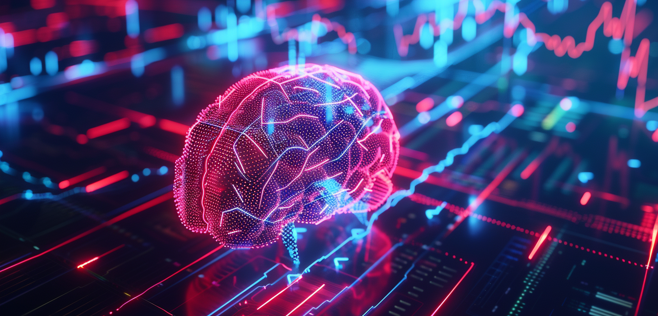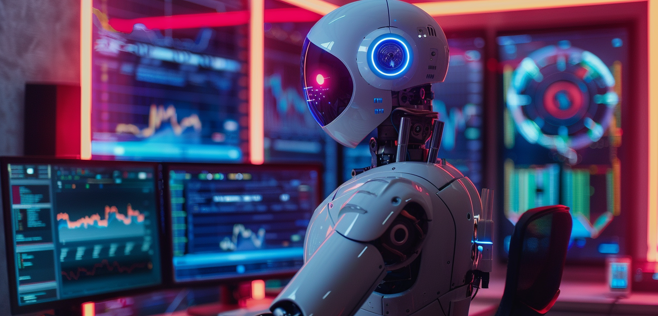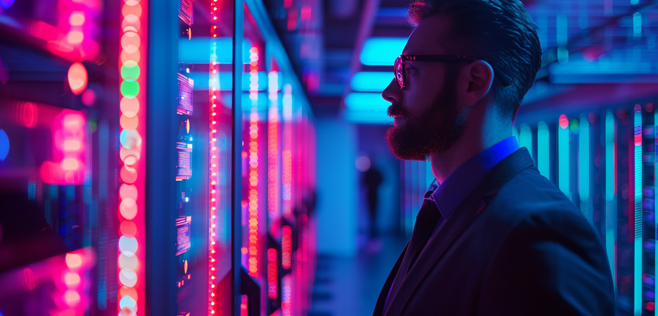Published 04 Aug 2025
The Truth About AI Trading: Can Machines Really Beat Human Investors in 2025?

AI and investing are coming together in dramatic ways. A recent industry survey shows that more than 90% of investment managers currently use or plan to use AI in their investment strategies. The adoption rate is significant, with 54% already implementing these technologies. The actual performance tells a different story. Studies reveal AI-powered investing achieves only a 51% success rate in the best scenarios.
AI crypto investing has become more popular these days. Stablecoins have reached a market cap of US$160 billion, which intensifies the debate between human judgment and machine-based investment approaches. AI brings clear benefits to investing, especially when you have massive data sets that need quick and efficient analysis. Many investment platforms now use immediate market insights and automated risk management. These platforms also employ predictive modeling to forecast long-term price trends. The big question as we approach 2025 remains unanswered - will machines beat human investors consistently? Some fundamental limitations of AI in investing might prove impossible to overcome.
How AI is Changing the Investment Landscape
The financial sector is going through a complete makeover as AI reshapes how we approach investments. Recent data shows that 78% of organizations used AI in 2024, up from 55% in 2023. This faster adoption marks a new chapter where algorithmic precision meets financial markets, creating both opportunities and challenges for investors.
AI vs traditional investing: what's different?
AI-driven and human-managed funds work in completely different ways. Professional human fund managers rely on predictive judgment, fundamental analysis, and market intuition. AI-driven funds, on the other hand, work through quantitative models, machine learning algorithms, and automated execution systems. These AI systems can analyze big datasets, spot trading patterns, and execute trades at speeds that humans simply can't match.
AI trading's most important advantage is its ability to reduce emotional biases that often affect human investors, such as overconfidence, herd mentality, and loss aversion. AI systems work with steady objectivity and make consistent decisions whatever the market conditions.
Human traders shine in areas that AI doesn't deal very well with - especially when you have to understand market sentiment, adapt to unexpected events, and apply ethical judgment to complex situations. Human intuition becomes vital during unpredictable market events or when new trends don't match historical patterns.
The rise of AI-powered investing tools
AI has become essential in investment management. It works not as a replacement for human managers but as what industry experts call a "tireless quant assistant". These sophisticated tools give investors powerful new capabilities:
-
Better data processing: AI systems analyze market data live to spot opportunities humans might miss
-
Sentiment analysis: Natural language processing now scans news, earnings calls, and social media to detect market sentiment changes before they show up in prices
-
Dynamic portfolio management: AI helps investors adjust portfolios faster to market changes, giving them a complete portfolio view and better risk visibility
Combining video, audio, and text through new AI technologies offers promising improvements in predictive accuracy. Major institutions also utilize generative AI to combine internal and external knowledge or process thousands of private asset documents for smarter investment decisions.
Why 2025 is a turning point for AI in investing
The investment landscape stands at a crucial turning point. U.S. private AI investment reached $109.10 billion in 2024 – dwarfing China's $9.30 billion and the UK's $4.50 billion. Generative AI pulled in $33.90 billion globally, growing 18.7% from 2023.
The focus moves toward practical applications and financial results as we look toward 2025. AI-native companies should develop strong annual recurring revenue. Investors now balance their portfolio risk by backing companies with clear mid-term revenue potential. Investment attention has shifted from infrastructure (hardware, hyperscalers, and AI models) to customer-facing applications that optimize business workflows.
Regulations will shape 2025 significantly. U.S. federal agencies rolled out 59 AI-related regulations in 2024 – more than twice the number from 2023. This regulatory focus, plus increasing private equity involvement and merger activity in the AI sector, shows a maturing market that's moving from speculative interest to proven business practice. Success in this evolving landscape belongs to firms that blend AI capabilities with human expertise effectively. These hybrid approaches tap into the full potential of both while reducing their weaknesses.

Understanding AI Trading Models
AI trading models power modern financial technology. Complex algorithms interpret market behavior and execute trades. These smart systems analyze everything from past price movements to up-to-the-minute news and turn raw data into useful investment decisions.
How machine learning predicts market trends
Machine learning algorithms spot patterns in historical market data that humans might miss. These systems process millions of transactions to find correlations and predict future price movements based on similar past scenarios. AI can process huge datasets at once, which helps it detect subtle signals across markets and timeframes.
Predictive analytics drives AI-powered trading strategies. These tools forecast market movements by looking at past trends, statistical models, and economic indicators. Traders get more accurate entry and exit points, better trading strategies, and improved risk management.
Long Short-Term Memory (LSTM) networks work great for stock price prediction because they know how to remember key information while filtering out noise. This selective memory helps LSTM models tell the difference between short-term changes and meaningful long-term trends, which makes them perfect for handling time-flexible data structures that show high predictability.
Types of AI used in trading: supervised vs unsupervised
Supervised learning leads the pack in financial markets. These models learn from labeled datasets where correct outputs are known. Stock trading systems typically use historical price data with known outcomes to teach the system how to make accurate predictions about future price movements.
Popular supervised learning techniques in trading include:
- Linear regression for short-term price forecasting
- Support vector machines for trend prediction
- Random forests that build multiple decision trees to reduce overfitting
- Neural networks that capture complex market relationships
Unsupervised learning works differently — it finds hidden patterns in raw information without labeled data. These models excel at spotting market regimes, structural changes, and new trends that break from historical patterns. By grouping large amounts of unlabeled data, unsupervised algorithms can spot changes in investor behavior early.
The Bank for International Settlements shows that combining both approaches boosts predictive power and risk awareness by a lot. This mixed strategy lets trading systems use supervised learning's accuracy while staying flexible enough to adapt to new market conditions through unsupervised techniques.
The role of data in training AI models
Data quality makes or breaks AI trading success. Prominent AI researcher Andrew Ng points out that data preparation takes up about 80% of machine learning projects. This shows how crucial it is to collect, clean, and prepare financial data before feeding it to trading algorithms.
Training starts with historical market data to understand price movements and patterns. Teams must clean this information carefully to remove any oddities that could confuse the algorithms. Good data sources help create stable systems and cut down cleaning costs.
Modern AI trading systems use many types of data:
- Financial statements and economic indicators
- News sentiment and social media analysis
- Alternative data from satellite imagery and other unique sources
The challenge lies in keeping data quality high while analyzing more information. Even the smartest algorithms will fail with bad or incomplete data. Financial institutions need strong data governance frameworks to ensure their AI trading models stay reliable.

Can AI Really Beat Human Investors?
The latest performance data shows an eye-opening reality about the battle between artificial intelligence and human investors. Both approaches compete to dominate an ever-changing market environment, which raises the question: can machines really beat their human counterparts?
Performance comparison: AI vs human traders
The numbers paint a clear picture. Studies show AI reaches about 60% accuracy to predict earnings changes and beats human analysts who hit 53-57% accuracy. This gap might look small, but these small edges add up over time.
AI-driven trading systems process data and complete trades in milliseconds — they work 10 to 20 times faster than human traders. This speed edge has pushed AI-powered high-frequency trading to handle 60-73% of all equity trading in the United States.
Machines have the upper hand in precision too. AI integration in trading has boosted trade execution accuracy by 20% compared to standard methods. Traders who use AI tools have seen their decision consistency improve by 15-20%. This happens because AI runs on analytical algorithms without emotional bias.
Case study: AI crypto investing in volatile markets
The crypto market serves as an ideal testing ground to showcase AI capabilities. Coingecko research reveals that 87% of crypto users would trust AI agents with at least 10% of their crypto portfolio, while 36% would let AI manage most of their digital assets.
Growth projections tell an impressive story — experts expect the crypto AI market to hit $3.30 billion by 2029, with a remarkable 34.2% compound annual growth rate. This quick growth comes from AI's skill to handle round-the-clock crypto markets and react quickly to price swings.
AI trading agents spot sudden market shifts and move holdings based on preset risk limits. To cite an instance, see how an AI system might sell volatile assets and buy stablecoins during a market drop — tasks that need quick action from human traders.
Where AI outperforms — and where it doesn't
AI leads in several key areas:
- Speed and data processing: AI trades in 0.01 seconds while humans take 0.1-0.3 seconds
- Emotional control: No fear, greed, or panic in trading choices
- Consistency: Strict strategy following without changes
Humans still hold crucial advantages. During unexpected events like early COVID-19 or sudden political crises, human traders often perform better than machines. People adapt quickly, grasp context, and make calls when there's no past data to guide them.
Collaboration beats competition in this arena. Companies that use AI-assisted trading models have boosted their operational efficiency by 27% compared to those using only human effort. The market keeps changing, and the best strategy combines AI's analytical strength with human oversight.

Limitations and Risks of Using AI for Investing
AI shows great promise in investment markets, but several key limitations could weaken its performance in ground scenarios. Investors need to learn about these constraints as they deal with the complex mix of artificial intelligence and investing.
Bias in training data and its effect
AI systems inherit biases because they depend on human modeling and historical data that mirror existing societal inequalities. These biases can create unfair outcomes or prejudiced decisions against groups based on race, gender, or socioeconomic status. Financial applications suffer when AI-based lending decisions reflect negative socioeconomic trends. Problems become systemic when institutions operate in ways that put certain social groups at a disadvantage.
Overfitting and false signals
Overfitting happens when trading strategies become too focused on historical data and mistake random noise for patterns. This creates a dangerous gap — strategies look great during backtesting but fail badly in live trading. Research from AQR Capital Management shows a moving average strategy's Sharpe ratio dropped from 1.2 to -0.2 with fresh data. A 2014 study also found that all but one of these published trading strategies failed to match their success with new data.
Lack of transparency in AI decision-making
Advanced AI systems work like a "black box", which creates big challenges for regulators and investor trust. Deep learning models and neural networks make decisions that are hard to understand, question, or improve. The European Central Bank warns that AI could distort asset prices, increase market associations, promote herding behavior, and help create bubbles. Companies often don't document their training data content — even internally — which makes transparency problems worse.
Overreliance on automation
Too much dependence on AI systems can make markets vulnerable. During stressful periods, AI-based trading systems might use similar trading strategies when they see the same price signals. This could create fragile and highly linked markets. The International Monetary Fund points out that algorithmic trading strategies often have safety triggers that cause de-risking or shutdowns during high volatility. These actions could create destabilizing feedback loops and sudden drops in market liquidity. Past events like the 2010 "Flash Crash" and 2007 "Quant Quake" show how technology-driven market disruptions can quickly get out of hand.
The Human Edge: What Machines Still Can’t Do
Machines are great at crunching huge amounts of data. But human investors have special skills that today's AI can't match. These natural advantages give human traders the upper hand, even as technology gets better.
Emotional intelligence and market intuition
Human investors can read market sentiment that goes far beyond numbers and charts. Their emotional intelligence helps them catch subtle hints during earnings calls. They can tell if management is trustworthy and spot changes in market psychology. This natural understanding works better when looking at new market players or complex situations without much history. Research shows that seasoned investors' brains process emotional market signals in ways that AI models can't copy.
Adapting to black swan events
Humans are amazing at handling unexpected crises. AI struggles with rare events that have no historical match. But human investors can process new information faster, spot broken patterns, and come up with creative solutions. The COVID-19 pandemic proved this point - fund managers who adjusted their strategies did better than rigid computer systems during the market's early chaos.
Ethical judgment and long-term thinking
Good investing needs more than just number crunching. It requires ethical judgment and understanding how decisions affect society. Human investors know how to factor in ESG concerns, geopolitical risks, and moral issues into their choices. They also have the patience and long-term view to balance quick profits against green practices in ways that most AI systems still don't understand.

Conclusion
The relationship between AI and human investing looks more complementary than competitive as we approach 2025. Without doubt, AI systems show remarkable capabilities. They predict earnings changes with 60% accuracy compared to humans' 53-57%. Their execution speed reaches millisecond levels. Machines also maintain consistency advantages over human traders by eliminating emotional bias.
All the same, human investors possess crucial strengths that AI cannot yet match. Their emotional intelligence helps them understand subtle market sentiment beyond pure numbers. Humans also perform better during unprecedented market events where past patterns offer little guidance. The COVID-19 pandemic proved this point. Flexible human traders outperformed rigid algorithms during the original market chaos.
The future of investing doesn't lie in choosing between humans or machines. It focuses on developing sophisticated hybrid approaches. Companies that use AI-assisted models have achieved 27% better operational efficiency than those depending only on human effort. The most successful strategies will combine AI's computational power with human strategic oversight, ethical judgment, and adaptability.
AI private investment has reached $109.10 billion in 2024, and technological adoption keeps accelerating. Yet machine learning's basic limitations suggest that human expertise remains vital. These limitations include data bias, overfitting, and systemic problems with transparency. Machines excel at processing past events, but humans still navigate new situations better.
The focus now changes from AI beating human investors to finding ways these approaches can complement each other. Success in this evolving digital world belongs to those who blend technological capabilities with human insight effectively. This creates investment strategies that use both sides' unique strengths while reducing their weaknesses.
Read More




 Get RateX Pro
Get RateX Pro

 06 Jun 2024
06 Jun 2024
